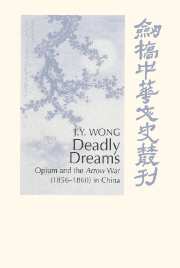Book contents
- Frontmatter
- Contents
- List of Tables
- List of Figures
- Poem by the late Mr Qin Esheng
- Foreword by Professor Wang Gungwu
- Foreword by Professor C. A. Bayly
- Preface
- Part I The confusion of imperialism
- Part II The pretext for imperialism
- 2 An international incident: ‘That wretched question of the Arrow’
- Part III The personalities of imperialism
- Part IV The rhetoric of imperialism
- Part V The mechanics of imperialism
- Part VI The economics of imperialism
- Part VII The dynamics of imperialism
- Chronology of major events
- Word list
- Abbreviations
- Bibliography
- Index
2 - An international incident: ‘That wretched question of the Arrow’
Published online by Cambridge University Press: 29 September 2009
- Frontmatter
- Contents
- List of Tables
- List of Figures
- Poem by the late Mr Qin Esheng
- Foreword by Professor Wang Gungwu
- Foreword by Professor C. A. Bayly
- Preface
- Part I The confusion of imperialism
- Part II The pretext for imperialism
- 2 An international incident: ‘That wretched question of the Arrow’
- Part III The personalities of imperialism
- Part IV The rhetoric of imperialism
- Part V The mechanics of imperialism
- Part VI The economics of imperialism
- Part VII The dynamics of imperialism
- Chronology of major events
- Word list
- Abbreviations
- Bibliography
- Index
Summary
I. The history of the Arrow
The Arrow was a lorcha, a kind of Western schooner with Chinese rigging. According to one of her sailors, she was built in China in 1854 by a Chinese subject called Su Acheng. She was subsequently sold to another Chinese subject, Fong Ah-ming, who had lived in Hong Kong for about ten years and who registered the ship there on 27 September 1855. On the basis of this registration, Consul Parkes maintained that the Arrow was a bona fide British vessel.
By her colonial registration, the Arrow was granted permission to fly the British flag and claim British protection. Her crew consisted entirely of Chinese sailors, with the exception of the captain, who, as mentioned, was an Irishman of age twenty-one by the name of Thomas Kennedy. He candidly admitted that he had been put on board merely as nominal master of the vessel. Thus, here was a vessel built in China, owned by a Chinese subject, manned by a Chinese crew, and sailing in Chinese waters, but claiming British protection. This ambiguity could easily give rise to misconceptions as to her nationality. If she were at sea flying British colours, she could be identified as a British vessel. But if she sailed into a port in China, lowered her flags in accordance with British nautical practice, dropped anchor, and her British captain left, she could be mistaken for a Chinese boat.
- Type
- Chapter
- Information
- Deadly DreamsOpium and the Arrow War (1856–1860) in China, pp. 43 - 66Publisher: Cambridge University PressPrint publication year: 1998



